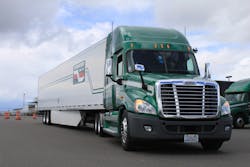The addition of emission control technology to commercial-grade trucks, along with other changes driven by federal greenhouse gas (GHG) rules and other regulations, is also generating a shift in fleet spec’ing strategies or at least should convince fleets to examine their current specs more carefully, according to several experts.
“[They are] affecting purchasing decisions; driving up new asset costs which [are] causing other concerns downstream, such as residual values of used equipment, depreciation structures, leases versus owning; the list goes on and on,” Michael Jeffress, vice president of maintenance at Maverick Transportation LLC and past chairman of the American Trucking Associations (ATA) Technology & Maintenance Council (TMC), told Fleet Owner.
He points out that regulation changes – especially where fuel economy mandates are concerned – impact Maverick’s decision making process directly in regards to equipment spec’ing.
“Generally speaking, we are testing technology up to two years in advance of the regulation release or have made the decision many years prior to it even becoming a concern at the regulatory level to add such technology,” he explained.
“Items such as [putting] disc brakes on trailers in 2008, wide drum brake designs on tractors in 2010, [switching to] 13 liter engines in 2012, [and spec’ing] aluminum carriers for our rear axles in 2011 were all done in an effort to improve efficiencies and at the same time limit the impact caused by new regulations,” Jeffress said.
Ken Gillies, manager of truck purchasing and engineering for GE Capital Fleet Services, added that the addition of emission control technology such as diesel particulate filters (DPFs), the diesel exhaust fluid (DEF) tank and related selective catalytic reduction (SCR) systems is also affecting spec’ing efforts simply by reducing the amount of available “real estate” on the truck frame.
“If you order 100 trucks and the body installer tells you later on you have to relocate the DEF tank on all of them and that will cost you $200 per truck, that’s a big issue,” he explained. “You’ve got to understand the ramifications of everything you put on a truck today and that means for many customers changing or modifying specs they’ve used for years.”
There are also “side effects” to consider as well. “For example, for many fleets operating in California, they are moving to much more aerodynamic profiles for the tractor and trailer, along with tires with less rolling resistance to improve fuel economy,” Gillies said.
“Yet making the tractor-trailer more ‘slick’ aerodynamically and reducing the rolling resistance of tires can in some cases result in the need for more braking power since the tires roll easier and you have less wind resistance helping to slow a vehicle down,” he noted. “Thus that may require a fleet to upgrade to larger drum brakes or even air disc brakes to retain stopping power.”
Yet Gillies stressed that those and other regulatory impacts – along with assorted “ripple effects” – is also helping foster far more integrated discussions between OEMs, body upfitters, component suppliers, and fleets themselves in order to minimize any negatives occurring due to spec’ing changes.
“Across the board, even in the light-duty space, we’re seeing a lot more of this ‘integrated’ activity than ever before in regards to spec’ing,” he pointed out. “Indeed, we’ve been onsite with our customers addressing such issues at levels three times higher than we were last year. That’s because even what in the past might be considered ‘small’ items on a truck can today become ‘show stoppers’ in terms of costly spec’ing changes.”
About the Author
Sean Kilcarr
Editor in Chief
Sean Kilcarr is a former longtime FleetOwner senior editor who wrote for the publication from 2000 to 2018. He served as editor-in-chief from 2017 to 2018.
